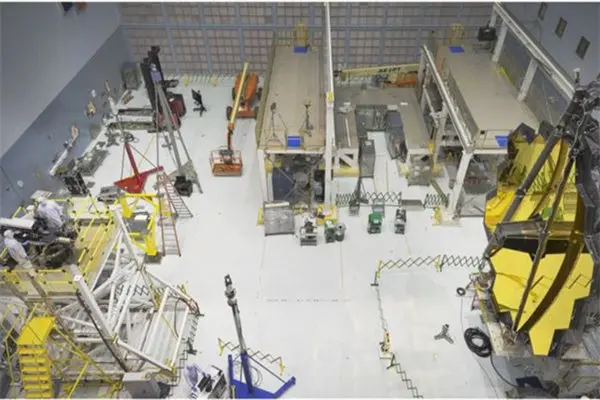Engineers have finished assembling the telescope that will succeed Hubble.
The huge new observatory known as James Webb is on track to be launched in exactly two years from now.
It will go into space on a European Ariane rocket from French Guiana, but before that is possible the delicate hardware must be tested to ensure it will survive the ride.
This work will begin in the coming weeks at the US space agency’s (Nasa) Goddard space centre in Maryland.
"We have to shake it as it will be shaken by the rocket," explained senior project scientist John Mather.
"Number two: we have to put loud noises on it, as it will feel the loud noises on launch - 150 decibels or something.
James web space telescope. Photo: bbc.com
"From here we go down to [the Johnson space centre in Texas] and prove that it focuses. That was the number one challenge: how do you know it will focus in space, especially after we learned that Hubble was not quite in focus when we launched?
"We’ve learned how to do that."
The James Webb Space Telescope (JWST) is a cooperative venture between Nasa and its European and Canadian counterparts.
When the contributions from all the parties are included, the value of this next-generation science facility is close to $10bn.
Webb will carry technologies capable of detecting the light from the first stars to shine in the Universe.
It will also reveal in unprecedented detail the chemistry and behaviour of planets far beyond our Solar System.
To help achieve this, it is fitted with a mirror that has a diameter of 6.5m - roughly seven times the light-collecting area of Hubble's main mirror.
This reflector is so big in fact that it must be capable of folding.
Only by turning the edges inwards will the beryllium/gold segments fit inside the enclosure atop the Ariane.
After years of development, the past 12 months have finally seen the telescope take on a recognisable form. And on Wednesday, Nasa called a media event to showcase the progress and to mark the milestone of two years to lift-off.
So far, everything is on track. “We’re on schedule and on cost,” said Nasa Administrator Charles Bolden.
Although we talk of the "telescope" being finished, this really only refers to the optical parts of the observatory - its mirrors and instruments.
Not yet incorporated into the full structure is the spacecraft bus, or chassis - that part that includes all the housekeeping hardware like the computers, telecommunications systems, and the thrusters to maintain Webb’s position in orbit.
Nor have engineers attached the giant shield that will shade Webb's observations from the light of our Sun.
The sunshield covers an area similar to a tennis court. Photo: bbc.com
"The sunshield is as big a tennis court," quipped Dr Mather. "Try to imagine Roger Federer and Rafa (Nadal) running back and forth on our telescope. Imagine how large that is and what a difficult job it was. But it’s finished."
Aerospace contractor Northrop Grumman, which leads the Webb industrial programme, will bring all the elements together once this next phase of critical testing is done.
James Webb is a flagship mission for Nasa, Esa and CSA. It is also a high-risk project for them all.
Assuming the observatory survives the dangers of launch, it will take roughly six months to prepare for use by astronomers.
This commissioning period will involve a number of pivotal stages such as the unpacking of the mirror and the unfurling of the five-membrane sunshield.
Webb must then also be left to chill down to make it sensitive to the infrared light coming from the most distant stars in the cosmos.
Those six months ahead of routine science are already being dubbed the "six months of terror" because of the requirement for all of the in-space deployments to go exactly to plan. And unlike with Hubble, there will be no astronauts available to fix a problem after launch because Webb will be stationed too far away for them to reach - about 1.5 million km from Earth.
This underlined the need to make sure the coming months’ testing was performed with care, said Dr Mather. "We need to make sure we won’t be terrified by doing our job now."
(BBC)
 简体中文
简体中文



